Evaluating the Effect of FDI on Economic Growth in Australia: A Report
VerifiedAdded on 2023/06/06
|18
|4105
|125
Report
AI Summary
This research report investigates the relationship between Foreign Direct Investment (FDI) and economic growth in Australia, focusing on the period from 2007 to 2017. The study aims to determine how the inflow of FDI impacts Australia's economic prosperity. The report begins with an executive summary, table of contents, and introduction outlining the research question and objectives. A thorough literature review explores both the positive and negative impacts of FDI on economic growth, including the neo-classical growth model and the effects of technology transfer, capital accumulation, and market access. The methodology section details the data collection from the Australian Bureau of Statistics and the World Bank, followed by a quantitative analysis using descriptive statistics, bivariate correlation, and regression analysis. The findings reveal the average economic growth rate and FDI growth rate, alongside statistical analyses. The discussion interprets the results in relation to the hypothesis, and the report concludes by addressing the research aim, limitations, and offering recommendations based on the findings.
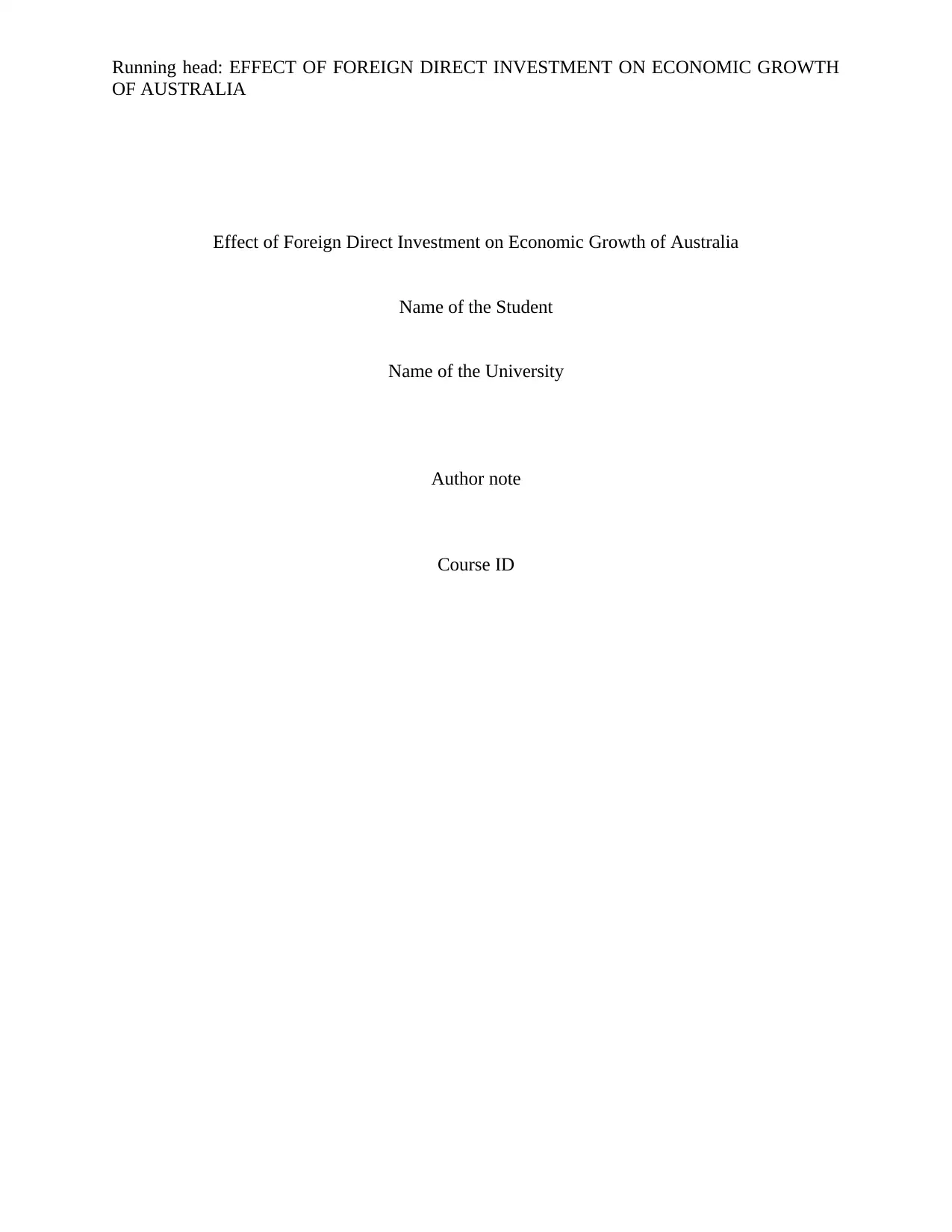
Running head: EFFECT OF FOREIGN DIRECT INVESTMENT ON ECONOMIC GROWTH
OF AUSTRALIA
Effect of Foreign Direct Investment on Economic Growth of Australia
Name of the Student
Name of the University
Author note
Course ID
OF AUSTRALIA
Effect of Foreign Direct Investment on Economic Growth of Australia
Name of the Student
Name of the University
Author note
Course ID
Paraphrase This Document
Need a fresh take? Get an instant paraphrase of this document with our AI Paraphraser

1EFFECT OF FOREIGN DIRECT INVESTMENT ON ECONOMIC GROWTH OF
AUSTRALIA
Executive Summary
In the research paper, evaluation has been made regarding the interconnectedness between
economic growth and foreign direct investment in Australia. The particular research question is
how inflow of foreign direct investment in Australia affects economic growth of Australia.
Research scholars have conducted extensive research in evaluating relationship of FDI to that of
economic growth of a nation. The consensus from past literature tend to conclude in favor of a
positive bearing of foreign investment on economic prosperity through gains in efficiency and
productivity. The evidences from empirical literature however are not free from ambiguity. The
influence of FDI differs across countries and even varies depending on period under
consideration.
Data on foreign direct investment and economic growth of Australia has been collected from
official websites. The considered period of time under study extends from 2007 to 2017. The
secondary data are then analyzed applying quantitative method of research.
AUSTRALIA
Executive Summary
In the research paper, evaluation has been made regarding the interconnectedness between
economic growth and foreign direct investment in Australia. The particular research question is
how inflow of foreign direct investment in Australia affects economic growth of Australia.
Research scholars have conducted extensive research in evaluating relationship of FDI to that of
economic growth of a nation. The consensus from past literature tend to conclude in favor of a
positive bearing of foreign investment on economic prosperity through gains in efficiency and
productivity. The evidences from empirical literature however are not free from ambiguity. The
influence of FDI differs across countries and even varies depending on period under
consideration.
Data on foreign direct investment and economic growth of Australia has been collected from
official websites. The considered period of time under study extends from 2007 to 2017. The
secondary data are then analyzed applying quantitative method of research.
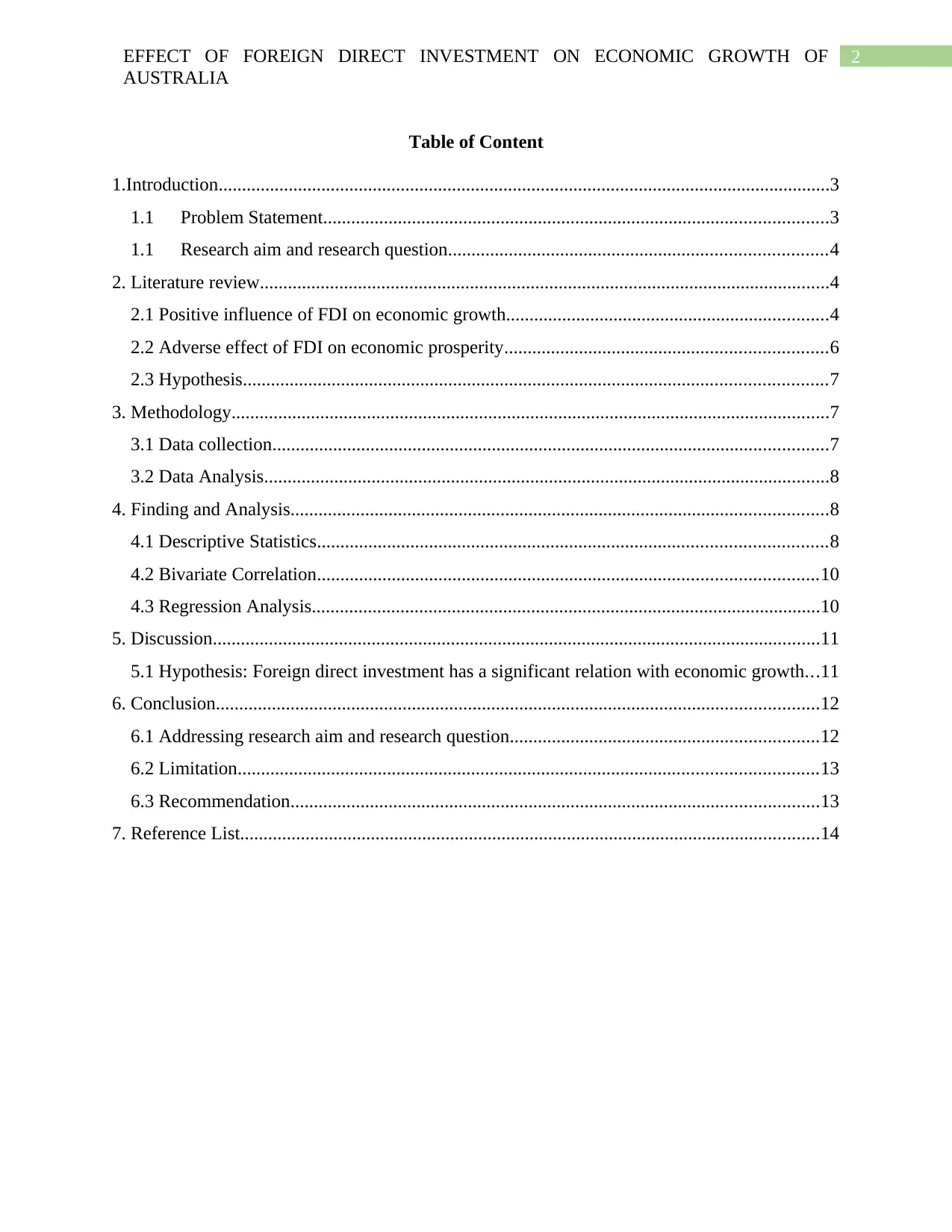
2EFFECT OF FOREIGN DIRECT INVESTMENT ON ECONOMIC GROWTH OF
AUSTRALIA
Table of Content
1.Introduction...................................................................................................................................3
1.1 Problem Statement............................................................................................................3
1.1 Research aim and research question.................................................................................4
2. Literature review..........................................................................................................................4
2.1 Positive influence of FDI on economic growth.....................................................................4
2.2 Adverse effect of FDI on economic prosperity.....................................................................6
2.3 Hypothesis.............................................................................................................................7
3. Methodology................................................................................................................................7
3.1 Data collection.......................................................................................................................7
3.2 Data Analysis.........................................................................................................................8
4. Finding and Analysis...................................................................................................................8
4.1 Descriptive Statistics.............................................................................................................8
4.2 Bivariate Correlation...........................................................................................................10
4.3 Regression Analysis.............................................................................................................10
5. Discussion..................................................................................................................................11
5.1 Hypothesis: Foreign direct investment has a significant relation with economic growth...11
6. Conclusion.................................................................................................................................12
6.1 Addressing research aim and research question..................................................................12
6.2 Limitation............................................................................................................................13
6.3 Recommendation.................................................................................................................13
7. Reference List............................................................................................................................14
AUSTRALIA
Table of Content
1.Introduction...................................................................................................................................3
1.1 Problem Statement............................................................................................................3
1.1 Research aim and research question.................................................................................4
2. Literature review..........................................................................................................................4
2.1 Positive influence of FDI on economic growth.....................................................................4
2.2 Adverse effect of FDI on economic prosperity.....................................................................6
2.3 Hypothesis.............................................................................................................................7
3. Methodology................................................................................................................................7
3.1 Data collection.......................................................................................................................7
3.2 Data Analysis.........................................................................................................................8
4. Finding and Analysis...................................................................................................................8
4.1 Descriptive Statistics.............................................................................................................8
4.2 Bivariate Correlation...........................................................................................................10
4.3 Regression Analysis.............................................................................................................10
5. Discussion..................................................................................................................................11
5.1 Hypothesis: Foreign direct investment has a significant relation with economic growth...11
6. Conclusion.................................................................................................................................12
6.1 Addressing research aim and research question..................................................................12
6.2 Limitation............................................................................................................................13
6.3 Recommendation.................................................................................................................13
7. Reference List............................................................................................................................14
⊘ This is a preview!⊘
Do you want full access?
Subscribe today to unlock all pages.

Trusted by 1+ million students worldwide
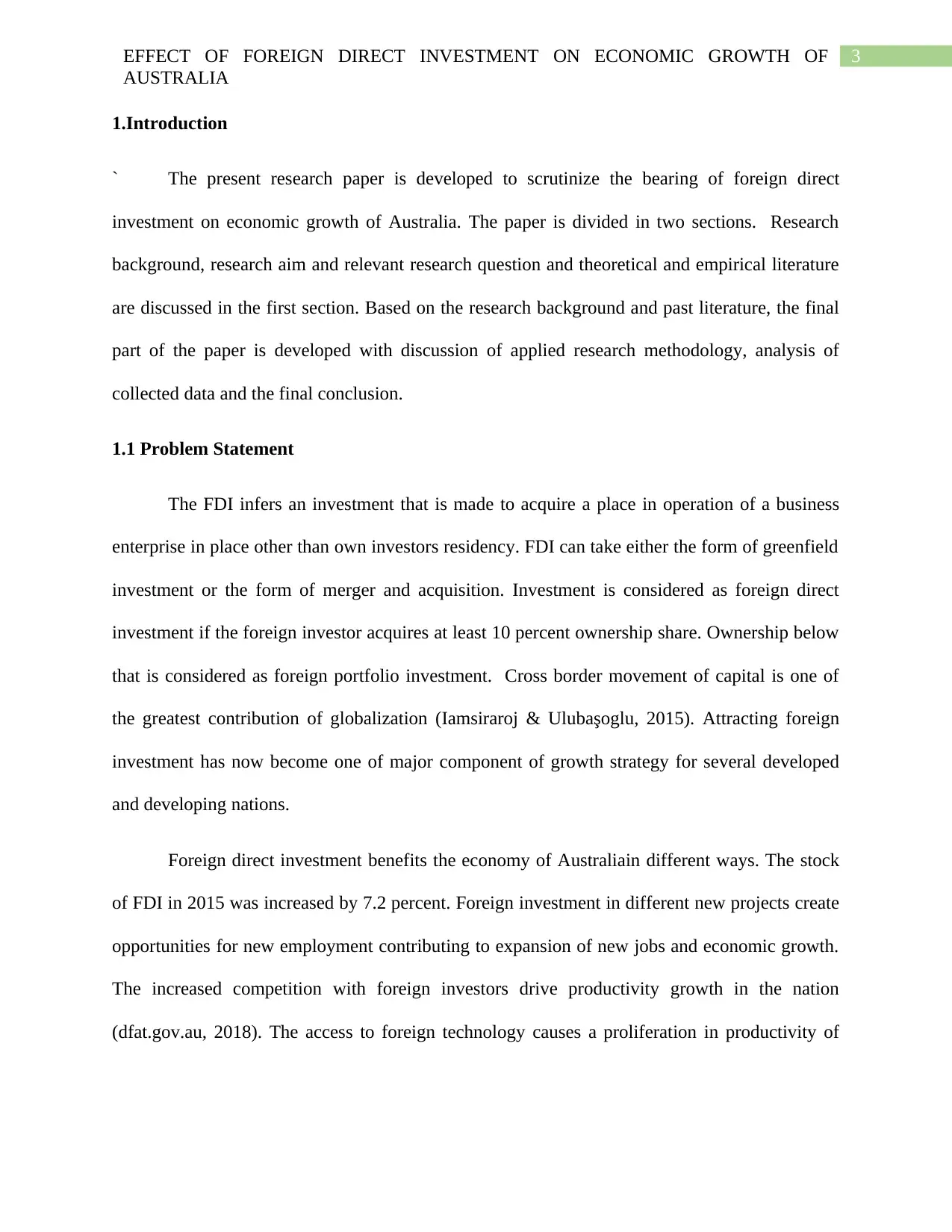
3EFFECT OF FOREIGN DIRECT INVESTMENT ON ECONOMIC GROWTH OF
AUSTRALIA
1.Introduction
` The present research paper is developed to scrutinize the bearing of foreign direct
investment on economic growth of Australia. The paper is divided in two sections. Research
background, research aim and relevant research question and theoretical and empirical literature
are discussed in the first section. Based on the research background and past literature, the final
part of the paper is developed with discussion of applied research methodology, analysis of
collected data and the final conclusion.
1.1 Problem Statement
The FDI infers an investment that is made to acquire a place in operation of a business
enterprise in place other than own investors residency. FDI can take either the form of greenfield
investment or the form of merger and acquisition. Investment is considered as foreign direct
investment if the foreign investor acquires at least 10 percent ownership share. Ownership below
that is considered as foreign portfolio investment. Cross border movement of capital is one of
the greatest contribution of globalization (Iamsiraroj & Ulubaşoglu, 2015). Attracting foreign
investment has now become one of major component of growth strategy for several developed
and developing nations.
Foreign direct investment benefits the economy of Australiain different ways. The stock
of FDI in 2015 was increased by 7.2 percent. Foreign investment in different new projects create
opportunities for new employment contributing to expansion of new jobs and economic growth.
The increased competition with foreign investors drive productivity growth in the nation
(dfat.gov.au, 2018). The access to foreign technology causes a proliferation in productivity of
AUSTRALIA
1.Introduction
` The present research paper is developed to scrutinize the bearing of foreign direct
investment on economic growth of Australia. The paper is divided in two sections. Research
background, research aim and relevant research question and theoretical and empirical literature
are discussed in the first section. Based on the research background and past literature, the final
part of the paper is developed with discussion of applied research methodology, analysis of
collected data and the final conclusion.
1.1 Problem Statement
The FDI infers an investment that is made to acquire a place in operation of a business
enterprise in place other than own investors residency. FDI can take either the form of greenfield
investment or the form of merger and acquisition. Investment is considered as foreign direct
investment if the foreign investor acquires at least 10 percent ownership share. Ownership below
that is considered as foreign portfolio investment. Cross border movement of capital is one of
the greatest contribution of globalization (Iamsiraroj & Ulubaşoglu, 2015). Attracting foreign
investment has now become one of major component of growth strategy for several developed
and developing nations.
Foreign direct investment benefits the economy of Australiain different ways. The stock
of FDI in 2015 was increased by 7.2 percent. Foreign investment in different new projects create
opportunities for new employment contributing to expansion of new jobs and economic growth.
The increased competition with foreign investors drive productivity growth in the nation
(dfat.gov.au, 2018). The access to foreign technology causes a proliferation in productivity of
Paraphrase This Document
Need a fresh take? Get an instant paraphrase of this document with our AI Paraphraser
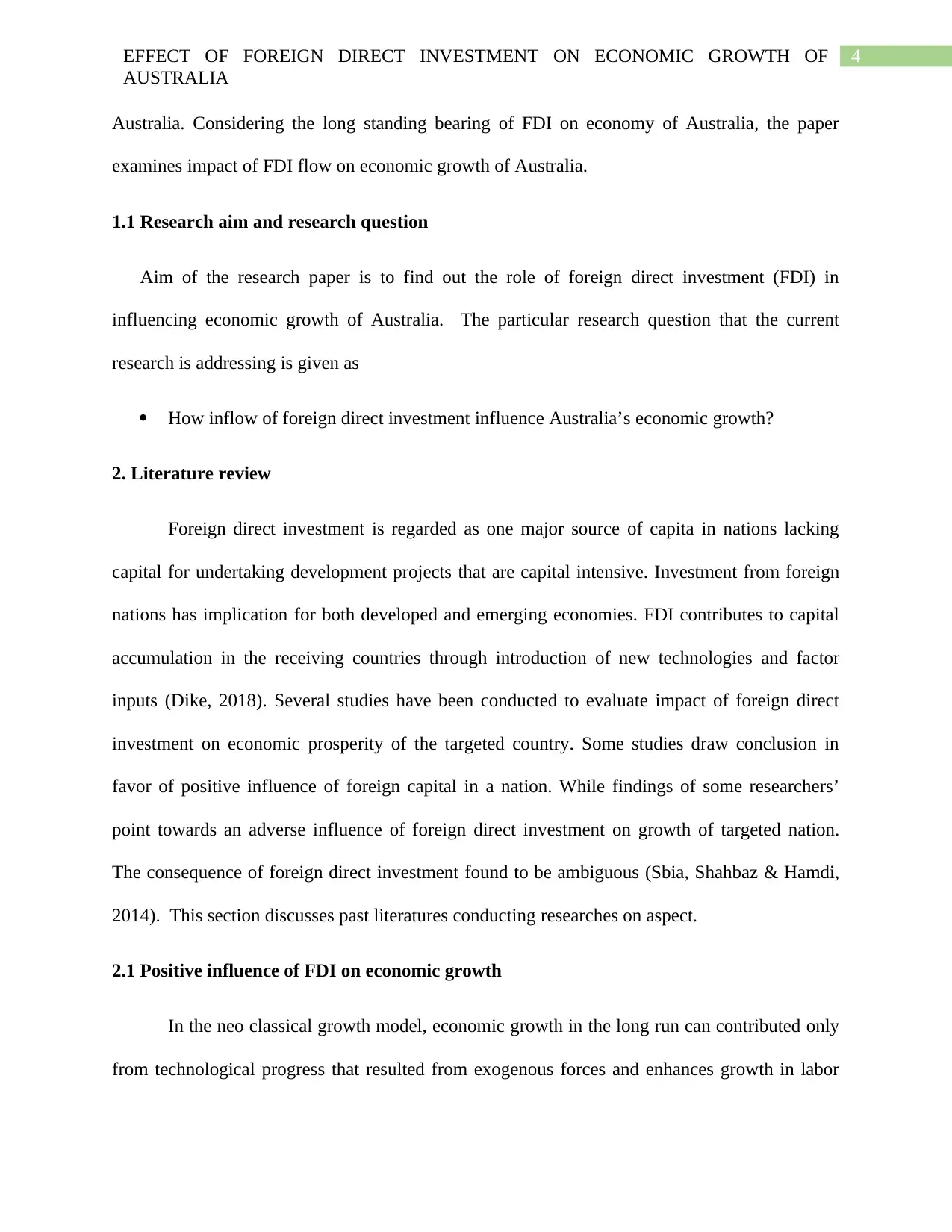
4EFFECT OF FOREIGN DIRECT INVESTMENT ON ECONOMIC GROWTH OF
AUSTRALIA
Australia. Considering the long standing bearing of FDI on economy of Australia, the paper
examines impact of FDI flow on economic growth of Australia.
1.1 Research aim and research question
Aim of the research paper is to find out the role of foreign direct investment (FDI) in
influencing economic growth of Australia. The particular research question that the current
research is addressing is given as
How inflow of foreign direct investment influence Australia’s economic growth?
2. Literature review
Foreign direct investment is regarded as one major source of capita in nations lacking
capital for undertaking development projects that are capital intensive. Investment from foreign
nations has implication for both developed and emerging economies. FDI contributes to capital
accumulation in the receiving countries through introduction of new technologies and factor
inputs (Dike, 2018). Several studies have been conducted to evaluate impact of foreign direct
investment on economic prosperity of the targeted country. Some studies draw conclusion in
favor of positive influence of foreign capital in a nation. While findings of some researchers’
point towards an adverse influence of foreign direct investment on growth of targeted nation.
The consequence of foreign direct investment found to be ambiguous (Sbia, Shahbaz & Hamdi,
2014). This section discusses past literatures conducting researches on aspect.
2.1 Positive influence of FDI on economic growth
In the neo classical growth model, economic growth in the long run can contributed only
from technological progress that resulted from exogenous forces and enhances growth in labor
AUSTRALIA
Australia. Considering the long standing bearing of FDI on economy of Australia, the paper
examines impact of FDI flow on economic growth of Australia.
1.1 Research aim and research question
Aim of the research paper is to find out the role of foreign direct investment (FDI) in
influencing economic growth of Australia. The particular research question that the current
research is addressing is given as
How inflow of foreign direct investment influence Australia’s economic growth?
2. Literature review
Foreign direct investment is regarded as one major source of capita in nations lacking
capital for undertaking development projects that are capital intensive. Investment from foreign
nations has implication for both developed and emerging economies. FDI contributes to capital
accumulation in the receiving countries through introduction of new technologies and factor
inputs (Dike, 2018). Several studies have been conducted to evaluate impact of foreign direct
investment on economic prosperity of the targeted country. Some studies draw conclusion in
favor of positive influence of foreign capital in a nation. While findings of some researchers’
point towards an adverse influence of foreign direct investment on growth of targeted nation.
The consequence of foreign direct investment found to be ambiguous (Sbia, Shahbaz & Hamdi,
2014). This section discusses past literatures conducting researches on aspect.
2.1 Positive influence of FDI on economic growth
In the neo classical growth model, economic growth in the long run can contributed only
from technological progress that resulted from exogenous forces and enhances growth in labor
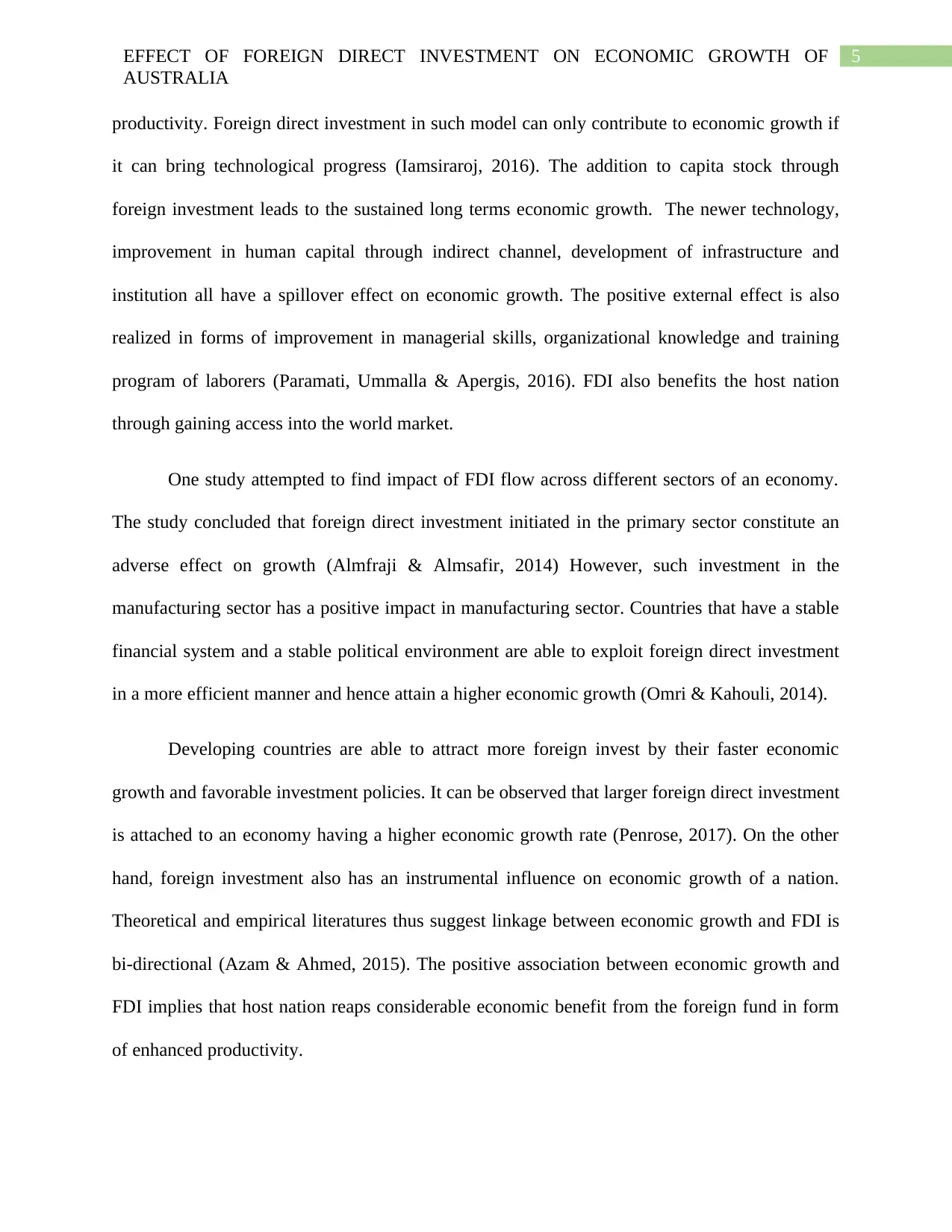
5EFFECT OF FOREIGN DIRECT INVESTMENT ON ECONOMIC GROWTH OF
AUSTRALIA
productivity. Foreign direct investment in such model can only contribute to economic growth if
it can bring technological progress (Iamsiraroj, 2016). The addition to capita stock through
foreign investment leads to the sustained long terms economic growth. The newer technology,
improvement in human capital through indirect channel, development of infrastructure and
institution all have a spillover effect on economic growth. The positive external effect is also
realized in forms of improvement in managerial skills, organizational knowledge and training
program of laborers (Paramati, Ummalla & Apergis, 2016). FDI also benefits the host nation
through gaining access into the world market.
One study attempted to find impact of FDI flow across different sectors of an economy.
The study concluded that foreign direct investment initiated in the primary sector constitute an
adverse effect on growth (Almfraji & Almsafir, 2014) However, such investment in the
manufacturing sector has a positive impact in manufacturing sector. Countries that have a stable
financial system and a stable political environment are able to exploit foreign direct investment
in a more efficient manner and hence attain a higher economic growth (Omri & Kahouli, 2014).
Developing countries are able to attract more foreign invest by their faster economic
growth and favorable investment policies. It can be observed that larger foreign direct investment
is attached to an economy having a higher economic growth rate (Penrose, 2017). On the other
hand, foreign investment also has an instrumental influence on economic growth of a nation.
Theoretical and empirical literatures thus suggest linkage between economic growth and FDI is
bi-directional (Azam & Ahmed, 2015). The positive association between economic growth and
FDI implies that host nation reaps considerable economic benefit from the foreign fund in form
of enhanced productivity.
AUSTRALIA
productivity. Foreign direct investment in such model can only contribute to economic growth if
it can bring technological progress (Iamsiraroj, 2016). The addition to capita stock through
foreign investment leads to the sustained long terms economic growth. The newer technology,
improvement in human capital through indirect channel, development of infrastructure and
institution all have a spillover effect on economic growth. The positive external effect is also
realized in forms of improvement in managerial skills, organizational knowledge and training
program of laborers (Paramati, Ummalla & Apergis, 2016). FDI also benefits the host nation
through gaining access into the world market.
One study attempted to find impact of FDI flow across different sectors of an economy.
The study concluded that foreign direct investment initiated in the primary sector constitute an
adverse effect on growth (Almfraji & Almsafir, 2014) However, such investment in the
manufacturing sector has a positive impact in manufacturing sector. Countries that have a stable
financial system and a stable political environment are able to exploit foreign direct investment
in a more efficient manner and hence attain a higher economic growth (Omri & Kahouli, 2014).
Developing countries are able to attract more foreign invest by their faster economic
growth and favorable investment policies. It can be observed that larger foreign direct investment
is attached to an economy having a higher economic growth rate (Penrose, 2017). On the other
hand, foreign investment also has an instrumental influence on economic growth of a nation.
Theoretical and empirical literatures thus suggest linkage between economic growth and FDI is
bi-directional (Azam & Ahmed, 2015). The positive association between economic growth and
FDI implies that host nation reaps considerable economic benefit from the foreign fund in form
of enhanced productivity.
⊘ This is a preview!⊘
Do you want full access?
Subscribe today to unlock all pages.

Trusted by 1+ million students worldwide
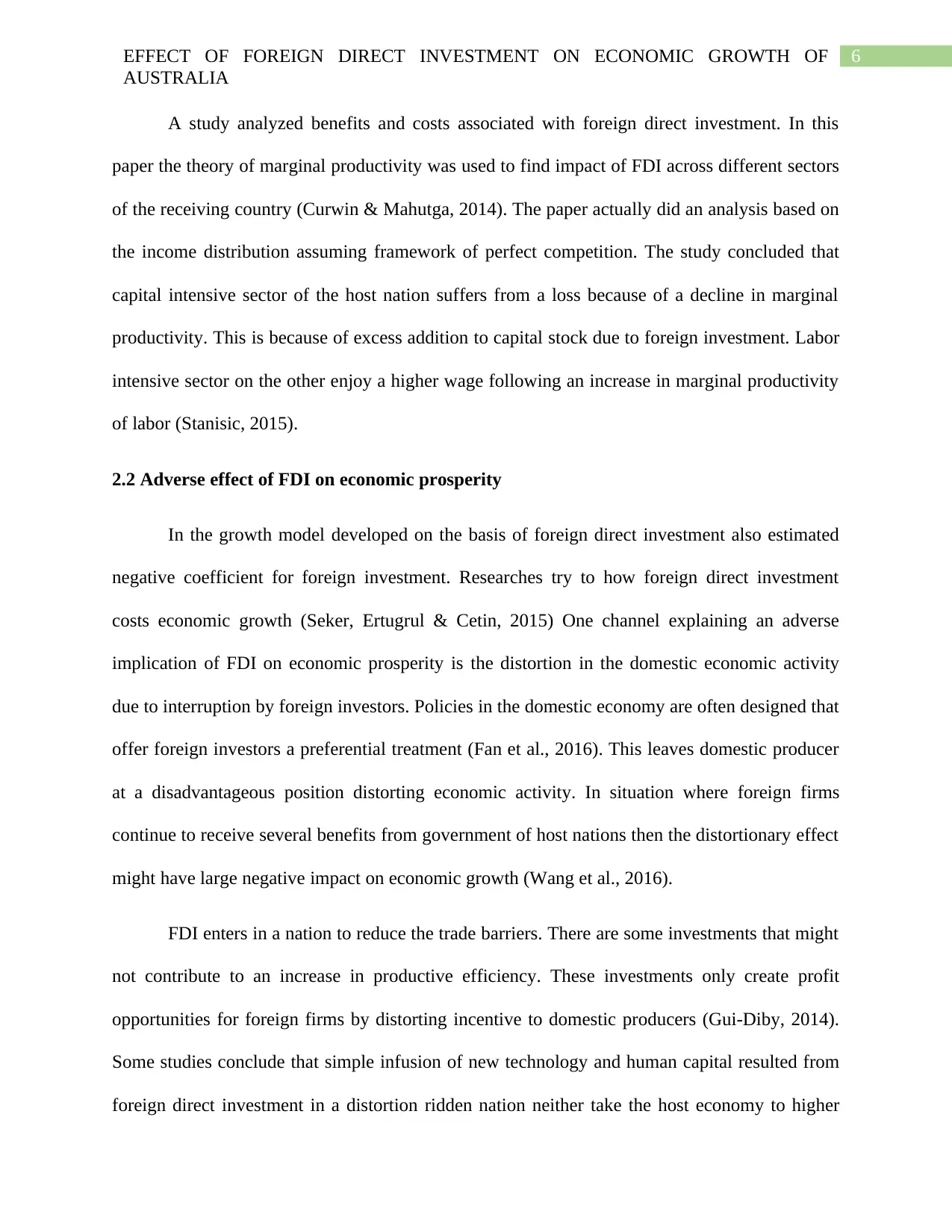
6EFFECT OF FOREIGN DIRECT INVESTMENT ON ECONOMIC GROWTH OF
AUSTRALIA
A study analyzed benefits and costs associated with foreign direct investment. In this
paper the theory of marginal productivity was used to find impact of FDI across different sectors
of the receiving country (Curwin & Mahutga, 2014). The paper actually did an analysis based on
the income distribution assuming framework of perfect competition. The study concluded that
capital intensive sector of the host nation suffers from a loss because of a decline in marginal
productivity. This is because of excess addition to capital stock due to foreign investment. Labor
intensive sector on the other enjoy a higher wage following an increase in marginal productivity
of labor (Stanisic, 2015).
2.2 Adverse effect of FDI on economic prosperity
In the growth model developed on the basis of foreign direct investment also estimated
negative coefficient for foreign investment. Researches try to how foreign direct investment
costs economic growth (Seker, Ertugrul & Cetin, 2015) One channel explaining an adverse
implication of FDI on economic prosperity is the distortion in the domestic economic activity
due to interruption by foreign investors. Policies in the domestic economy are often designed that
offer foreign investors a preferential treatment (Fan et al., 2016). This leaves domestic producer
at a disadvantageous position distorting economic activity. In situation where foreign firms
continue to receive several benefits from government of host nations then the distortionary effect
might have large negative impact on economic growth (Wang et al., 2016).
FDI enters in a nation to reduce the trade barriers. There are some investments that might
not contribute to an increase in productive efficiency. These investments only create profit
opportunities for foreign firms by distorting incentive to domestic producers (Gui-Diby, 2014).
Some studies conclude that simple infusion of new technology and human capital resulted from
foreign direct investment in a distortion ridden nation neither take the host economy to higher
AUSTRALIA
A study analyzed benefits and costs associated with foreign direct investment. In this
paper the theory of marginal productivity was used to find impact of FDI across different sectors
of the receiving country (Curwin & Mahutga, 2014). The paper actually did an analysis based on
the income distribution assuming framework of perfect competition. The study concluded that
capital intensive sector of the host nation suffers from a loss because of a decline in marginal
productivity. This is because of excess addition to capital stock due to foreign investment. Labor
intensive sector on the other enjoy a higher wage following an increase in marginal productivity
of labor (Stanisic, 2015).
2.2 Adverse effect of FDI on economic prosperity
In the growth model developed on the basis of foreign direct investment also estimated
negative coefficient for foreign investment. Researches try to how foreign direct investment
costs economic growth (Seker, Ertugrul & Cetin, 2015) One channel explaining an adverse
implication of FDI on economic prosperity is the distortion in the domestic economic activity
due to interruption by foreign investors. Policies in the domestic economy are often designed that
offer foreign investors a preferential treatment (Fan et al., 2016). This leaves domestic producer
at a disadvantageous position distorting economic activity. In situation where foreign firms
continue to receive several benefits from government of host nations then the distortionary effect
might have large negative impact on economic growth (Wang et al., 2016).
FDI enters in a nation to reduce the trade barriers. There are some investments that might
not contribute to an increase in productive efficiency. These investments only create profit
opportunities for foreign firms by distorting incentive to domestic producers (Gui-Diby, 2014).
Some studies conclude that simple infusion of new technology and human capital resulted from
foreign direct investment in a distortion ridden nation neither take the host economy to higher
Paraphrase This Document
Need a fresh take? Get an instant paraphrase of this document with our AI Paraphraser
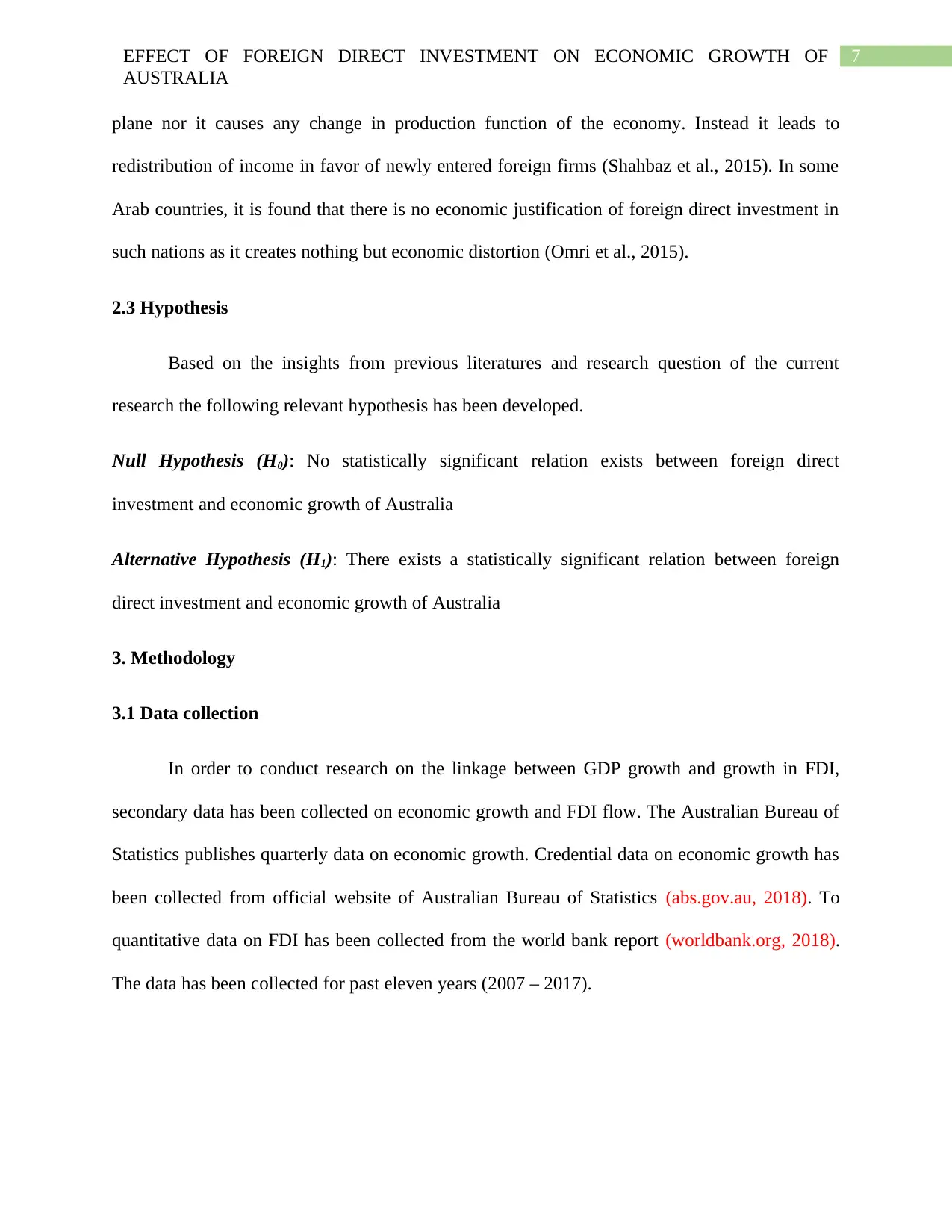
7EFFECT OF FOREIGN DIRECT INVESTMENT ON ECONOMIC GROWTH OF
AUSTRALIA
plane nor it causes any change in production function of the economy. Instead it leads to
redistribution of income in favor of newly entered foreign firms (Shahbaz et al., 2015). In some
Arab countries, it is found that there is no economic justification of foreign direct investment in
such nations as it creates nothing but economic distortion (Omri et al., 2015).
2.3 Hypothesis
Based on the insights from previous literatures and research question of the current
research the following relevant hypothesis has been developed.
Null Hypothesis (H0): No statistically significant relation exists between foreign direct
investment and economic growth of Australia
Alternative Hypothesis (H1): There exists a statistically significant relation between foreign
direct investment and economic growth of Australia
3. Methodology
3.1 Data collection
In order to conduct research on the linkage between GDP growth and growth in FDI,
secondary data has been collected on economic growth and FDI flow. The Australian Bureau of
Statistics publishes quarterly data on economic growth. Credential data on economic growth has
been collected from official website of Australian Bureau of Statistics (abs.gov.au, 2018). To
quantitative data on FDI has been collected from the world bank report (worldbank.org, 2018).
The data has been collected for past eleven years (2007 – 2017).
AUSTRALIA
plane nor it causes any change in production function of the economy. Instead it leads to
redistribution of income in favor of newly entered foreign firms (Shahbaz et al., 2015). In some
Arab countries, it is found that there is no economic justification of foreign direct investment in
such nations as it creates nothing but economic distortion (Omri et al., 2015).
2.3 Hypothesis
Based on the insights from previous literatures and research question of the current
research the following relevant hypothesis has been developed.
Null Hypothesis (H0): No statistically significant relation exists between foreign direct
investment and economic growth of Australia
Alternative Hypothesis (H1): There exists a statistically significant relation between foreign
direct investment and economic growth of Australia
3. Methodology
3.1 Data collection
In order to conduct research on the linkage between GDP growth and growth in FDI,
secondary data has been collected on economic growth and FDI flow. The Australian Bureau of
Statistics publishes quarterly data on economic growth. Credential data on economic growth has
been collected from official website of Australian Bureau of Statistics (abs.gov.au, 2018). To
quantitative data on FDI has been collected from the world bank report (worldbank.org, 2018).
The data has been collected for past eleven years (2007 – 2017).
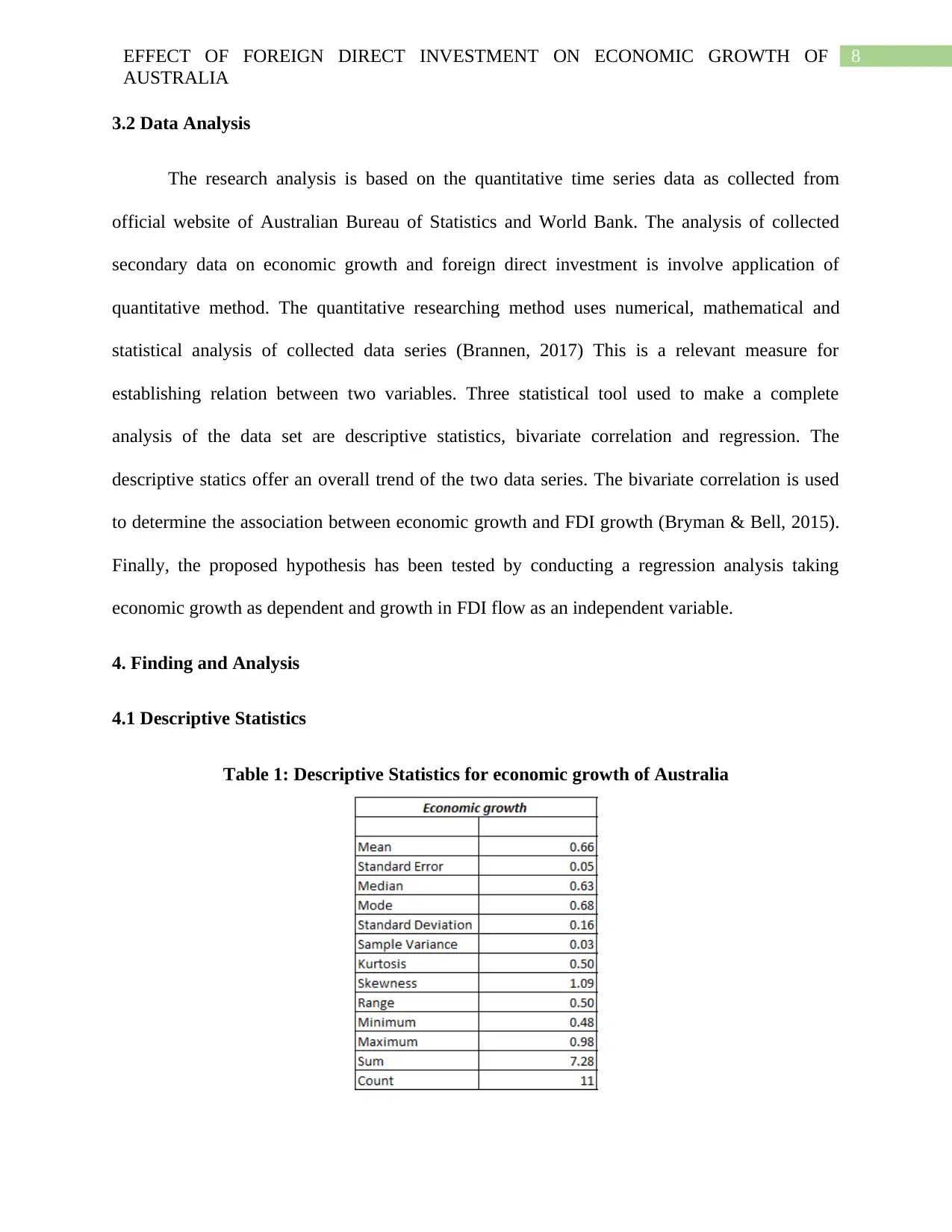
8EFFECT OF FOREIGN DIRECT INVESTMENT ON ECONOMIC GROWTH OF
AUSTRALIA
3.2 Data Analysis
The research analysis is based on the quantitative time series data as collected from
official website of Australian Bureau of Statistics and World Bank. The analysis of collected
secondary data on economic growth and foreign direct investment is involve application of
quantitative method. The quantitative researching method uses numerical, mathematical and
statistical analysis of collected data series (Brannen, 2017) This is a relevant measure for
establishing relation between two variables. Three statistical tool used to make a complete
analysis of the data set are descriptive statistics, bivariate correlation and regression. The
descriptive statics offer an overall trend of the two data series. The bivariate correlation is used
to determine the association between economic growth and FDI growth (Bryman & Bell, 2015).
Finally, the proposed hypothesis has been tested by conducting a regression analysis taking
economic growth as dependent and growth in FDI flow as an independent variable.
4. Finding and Analysis
4.1 Descriptive Statistics
Table 1: Descriptive Statistics for economic growth of Australia
AUSTRALIA
3.2 Data Analysis
The research analysis is based on the quantitative time series data as collected from
official website of Australian Bureau of Statistics and World Bank. The analysis of collected
secondary data on economic growth and foreign direct investment is involve application of
quantitative method. The quantitative researching method uses numerical, mathematical and
statistical analysis of collected data series (Brannen, 2017) This is a relevant measure for
establishing relation between two variables. Three statistical tool used to make a complete
analysis of the data set are descriptive statistics, bivariate correlation and regression. The
descriptive statics offer an overall trend of the two data series. The bivariate correlation is used
to determine the association between economic growth and FDI growth (Bryman & Bell, 2015).
Finally, the proposed hypothesis has been tested by conducting a regression analysis taking
economic growth as dependent and growth in FDI flow as an independent variable.
4. Finding and Analysis
4.1 Descriptive Statistics
Table 1: Descriptive Statistics for economic growth of Australia
⊘ This is a preview!⊘
Do you want full access?
Subscribe today to unlock all pages.

Trusted by 1+ million students worldwide
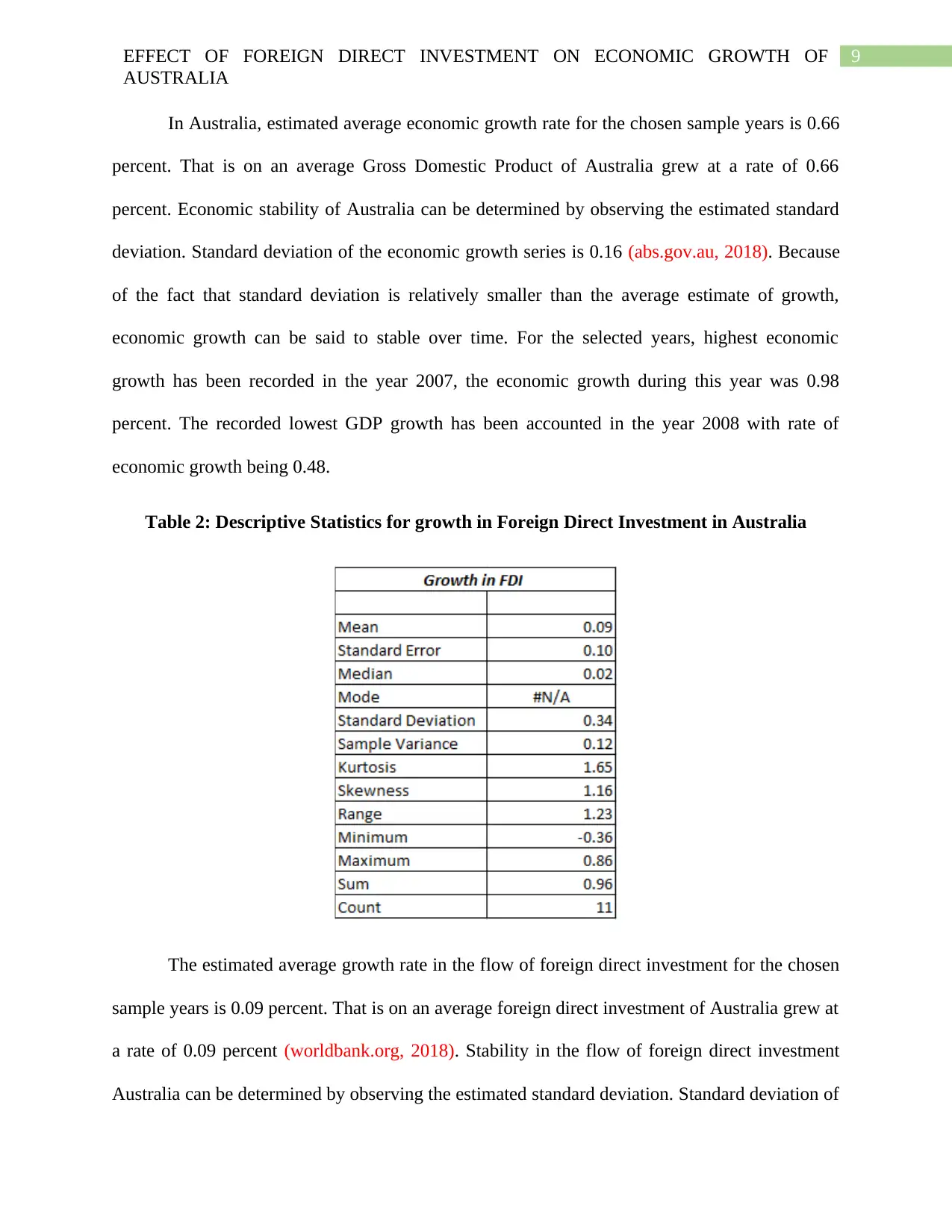
9EFFECT OF FOREIGN DIRECT INVESTMENT ON ECONOMIC GROWTH OF
AUSTRALIA
In Australia, estimated average economic growth rate for the chosen sample years is 0.66
percent. That is on an average Gross Domestic Product of Australia grew at a rate of 0.66
percent. Economic stability of Australia can be determined by observing the estimated standard
deviation. Standard deviation of the economic growth series is 0.16 (abs.gov.au, 2018). Because
of the fact that standard deviation is relatively smaller than the average estimate of growth,
economic growth can be said to stable over time. For the selected years, highest economic
growth has been recorded in the year 2007, the economic growth during this year was 0.98
percent. The recorded lowest GDP growth has been accounted in the year 2008 with rate of
economic growth being 0.48.
Table 2: Descriptive Statistics for growth in Foreign Direct Investment in Australia
The estimated average growth rate in the flow of foreign direct investment for the chosen
sample years is 0.09 percent. That is on an average foreign direct investment of Australia grew at
a rate of 0.09 percent (worldbank.org, 2018). Stability in the flow of foreign direct investment
Australia can be determined by observing the estimated standard deviation. Standard deviation of
AUSTRALIA
In Australia, estimated average economic growth rate for the chosen sample years is 0.66
percent. That is on an average Gross Domestic Product of Australia grew at a rate of 0.66
percent. Economic stability of Australia can be determined by observing the estimated standard
deviation. Standard deviation of the economic growth series is 0.16 (abs.gov.au, 2018). Because
of the fact that standard deviation is relatively smaller than the average estimate of growth,
economic growth can be said to stable over time. For the selected years, highest economic
growth has been recorded in the year 2007, the economic growth during this year was 0.98
percent. The recorded lowest GDP growth has been accounted in the year 2008 with rate of
economic growth being 0.48.
Table 2: Descriptive Statistics for growth in Foreign Direct Investment in Australia
The estimated average growth rate in the flow of foreign direct investment for the chosen
sample years is 0.09 percent. That is on an average foreign direct investment of Australia grew at
a rate of 0.09 percent (worldbank.org, 2018). Stability in the flow of foreign direct investment
Australia can be determined by observing the estimated standard deviation. Standard deviation of
Paraphrase This Document
Need a fresh take? Get an instant paraphrase of this document with our AI Paraphraser
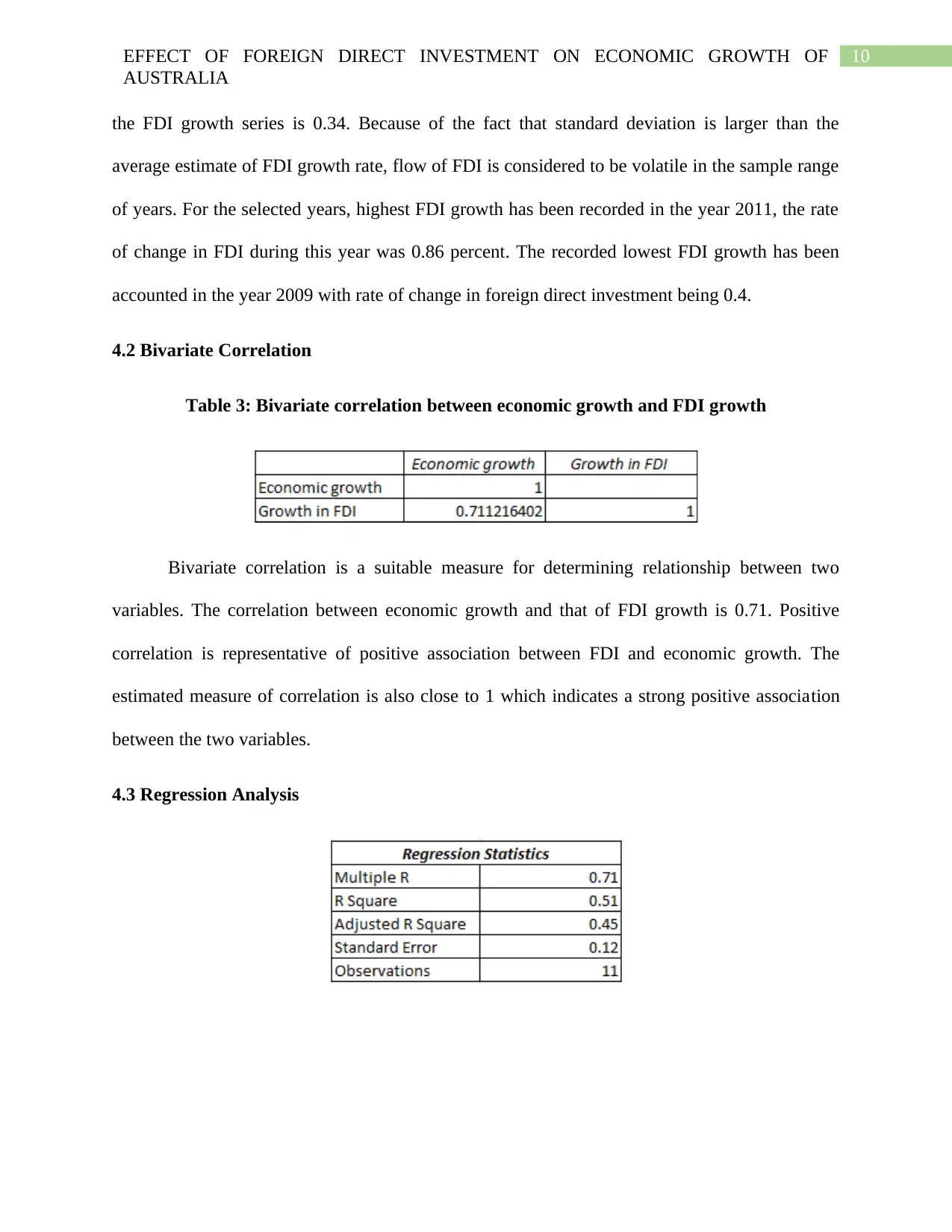
10EFFECT OF FOREIGN DIRECT INVESTMENT ON ECONOMIC GROWTH OF
AUSTRALIA
the FDI growth series is 0.34. Because of the fact that standard deviation is larger than the
average estimate of FDI growth rate, flow of FDI is considered to be volatile in the sample range
of years. For the selected years, highest FDI growth has been recorded in the year 2011, the rate
of change in FDI during this year was 0.86 percent. The recorded lowest FDI growth has been
accounted in the year 2009 with rate of change in foreign direct investment being 0.4.
4.2 Bivariate Correlation
Table 3: Bivariate correlation between economic growth and FDI growth
Bivariate correlation is a suitable measure for determining relationship between two
variables. The correlation between economic growth and that of FDI growth is 0.71. Positive
correlation is representative of positive association between FDI and economic growth. The
estimated measure of correlation is also close to 1 which indicates a strong positive association
between the two variables.
4.3 Regression Analysis
AUSTRALIA
the FDI growth series is 0.34. Because of the fact that standard deviation is larger than the
average estimate of FDI growth rate, flow of FDI is considered to be volatile in the sample range
of years. For the selected years, highest FDI growth has been recorded in the year 2011, the rate
of change in FDI during this year was 0.86 percent. The recorded lowest FDI growth has been
accounted in the year 2009 with rate of change in foreign direct investment being 0.4.
4.2 Bivariate Correlation
Table 3: Bivariate correlation between economic growth and FDI growth
Bivariate correlation is a suitable measure for determining relationship between two
variables. The correlation between economic growth and that of FDI growth is 0.71. Positive
correlation is representative of positive association between FDI and economic growth. The
estimated measure of correlation is also close to 1 which indicates a strong positive association
between the two variables.
4.3 Regression Analysis
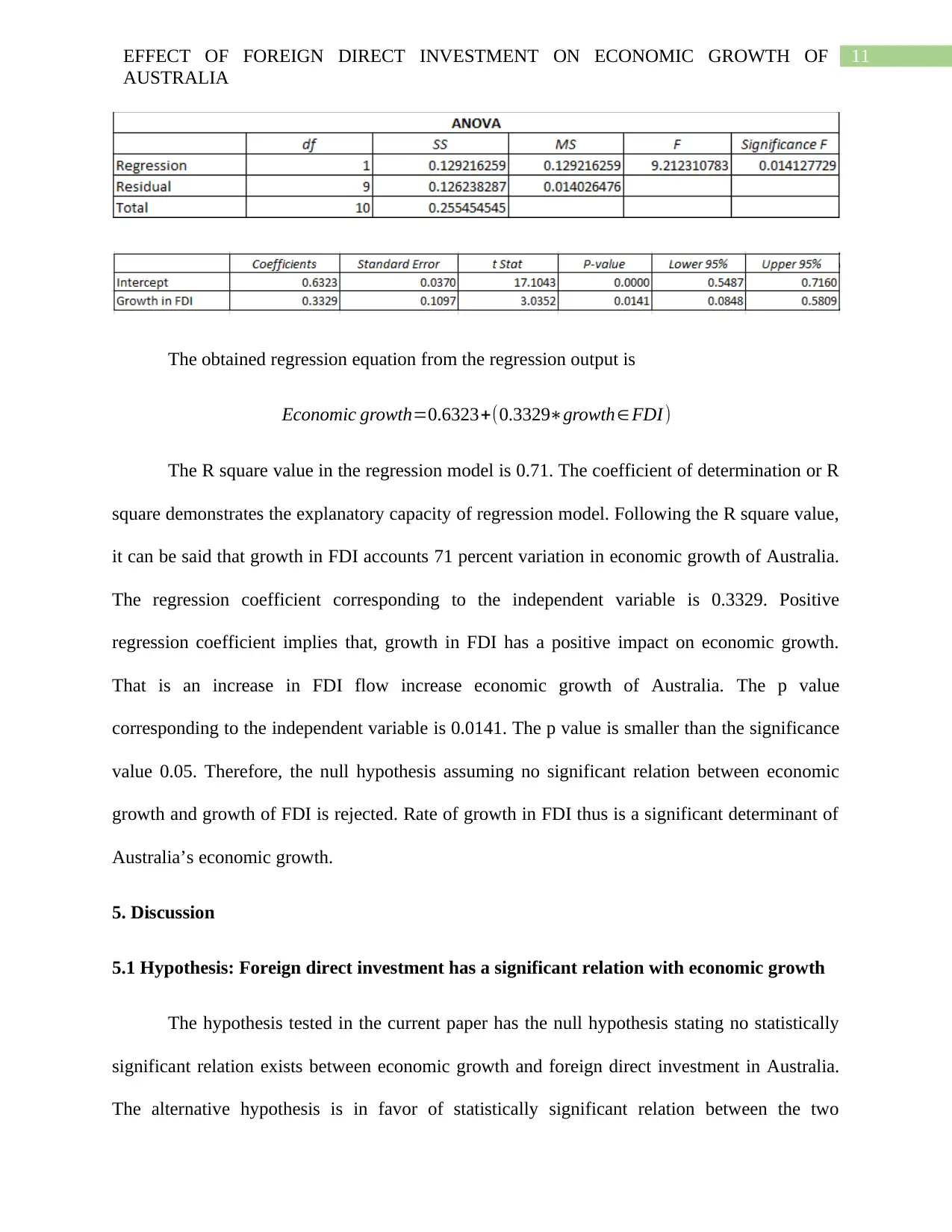
11EFFECT OF FOREIGN DIRECT INVESTMENT ON ECONOMIC GROWTH OF
AUSTRALIA
The obtained regression equation from the regression output is
Economic growth=0.6323+(0.3329∗growth∈FDI )
The R square value in the regression model is 0.71. The coefficient of determination or R
square demonstrates the explanatory capacity of regression model. Following the R square value,
it can be said that growth in FDI accounts 71 percent variation in economic growth of Australia.
The regression coefficient corresponding to the independent variable is 0.3329. Positive
regression coefficient implies that, growth in FDI has a positive impact on economic growth.
That is an increase in FDI flow increase economic growth of Australia. The p value
corresponding to the independent variable is 0.0141. The p value is smaller than the significance
value 0.05. Therefore, the null hypothesis assuming no significant relation between economic
growth and growth of FDI is rejected. Rate of growth in FDI thus is a significant determinant of
Australia’s economic growth.
5. Discussion
5.1 Hypothesis: Foreign direct investment has a significant relation with economic growth
The hypothesis tested in the current paper has the null hypothesis stating no statistically
significant relation exists between economic growth and foreign direct investment in Australia.
The alternative hypothesis is in favor of statistically significant relation between the two
AUSTRALIA
The obtained regression equation from the regression output is
Economic growth=0.6323+(0.3329∗growth∈FDI )
The R square value in the regression model is 0.71. The coefficient of determination or R
square demonstrates the explanatory capacity of regression model. Following the R square value,
it can be said that growth in FDI accounts 71 percent variation in economic growth of Australia.
The regression coefficient corresponding to the independent variable is 0.3329. Positive
regression coefficient implies that, growth in FDI has a positive impact on economic growth.
That is an increase in FDI flow increase economic growth of Australia. The p value
corresponding to the independent variable is 0.0141. The p value is smaller than the significance
value 0.05. Therefore, the null hypothesis assuming no significant relation between economic
growth and growth of FDI is rejected. Rate of growth in FDI thus is a significant determinant of
Australia’s economic growth.
5. Discussion
5.1 Hypothesis: Foreign direct investment has a significant relation with economic growth
The hypothesis tested in the current paper has the null hypothesis stating no statistically
significant relation exists between economic growth and foreign direct investment in Australia.
The alternative hypothesis is in favor of statistically significant relation between the two
⊘ This is a preview!⊘
Do you want full access?
Subscribe today to unlock all pages.

Trusted by 1+ million students worldwide
1 out of 18
Related Documents
Your All-in-One AI-Powered Toolkit for Academic Success.
+13062052269
info@desklib.com
Available 24*7 on WhatsApp / Email
![[object Object]](/_next/static/media/star-bottom.7253800d.svg)
Unlock your academic potential
Copyright © 2020–2025 A2Z Services. All Rights Reserved. Developed and managed by ZUCOL.





